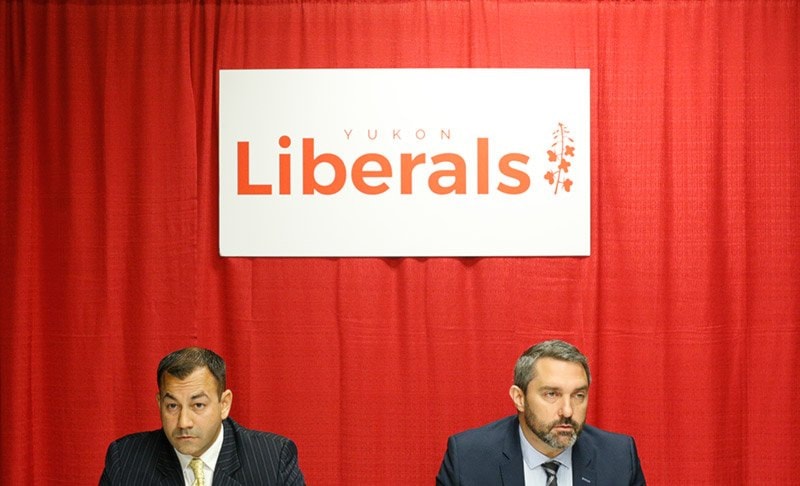Updated:
One new poll shows the Yukon Liberals with a big lead over the Yukon Party. A second poll shows a dead heat. The NDP says both should be taken with a grain of salt.
On Friday, the Liberals released the results of a poll they commissioned, showing them with a 16-point lead over the Yukon Party.
The survey, completed by the Toronto-based Gandalf Group, finds that the Liberals would have taken home 46 per cent of the vote had the election been held last week when the poll was conducted. The Yukon Party polled at 30 per cent, with the NDP trailing at 24 per cent.
The poll has a margin of error of 4.9 per cent.
The Gandalf Group surveyed 408 Yukoners on Oct. 25 and 26. It used a 50/50 mix of land lines and cell phones.
Respondents were asked which party they would vote for if the election were held today. The parties and leaders were then read out to them in random order. If they were unsure, they were asked if they were leaning toward any of the parties.
The survey results grouped together decided and leaning voters. Of those polled, 27 per cent said they would vote for the Liberals, 19 per cent for the Yukon Party and 16 per cent for the NDP. Twenty-six per cent were undecided.
Among undecided voters, 26 per cent said they were leaning toward the Liberals, 12 per cent toward the Yukon Party and 11 per cent toward the NDP.
Thirteen per cent of respondents were completely undecided.
Jennifer Espey, a principal partner with the Gandalf Group, said the methodology was “very solid,” and did not influence respondents in any way.
“You’re really trying to approximate what it would be like to vote,” she said.
Another principal partner at the Gandalf Group, David Herle, has worked on various Liberal campaigns, including Ontario Premier Kathleen Wynne’s re-election campaign in 2014.
In a statement issued Monday, NDP Leader Liz Hanson used that fact to cast doubt on the results. “The Liberals paid the campaign manager of the Ontario Liberals to conduct a poll for them,” she said. “I think Yukoners will reject this kind of cynical politics.”
But Espey said that affiliation has no influence on poll results, and Herle wasn’t involved with this particular poll.
“It doesn’t do a client any favours if you don’t find out the truth,” she said.
A second poll, from Yukon-based DataPath Systems, was released on Sunday. When voters were asked who they’d prefer as premier, Liberal Leader Sandy Silver had a three-point lead over Yukon Party Leader Darrell Pasloski and a 10-point lead over Hanson.
The DataPath poll also asked respondents to choose which party they would vote for in their riding, and found the Liberals and the Yukon Party were tied at 34 per cent. Twenty-nine per cent of respondents chose the NDP and three per cent chose the Green Party.
DataPath partner Donna Larsen compared the results to another poll she conducted last December, which showed the Liberals leading with 40 per cent of the vote and the Yukon Party at 25 per cent.
“I think the honeymoon’s over with the federal election results, and people have kind of gone back to their core party,” she said.
But the DataPath poll isn’t a random sample, as it’s sent out to a pre-existing email contact list. Larsen said that contact list now includes roughly 3,000 people. The survey results are based on 625 responses submitted between Oct. 15 and 23.
Larsen said there is nothing preventing people outside the territory from submitting responses, but they would have to lie about their location for their responses to be included in the results. She also said she only accepts two responses from each household, to prevent people from filling out the survey multiple times. She said she weeds out suspicious answers and duplicate surveys.
The DataPath poll would have a margin of error of 3.9 per cent, 19 times out of 20, if every Yukoner were on the mailing list and had an equal chance to respond, which is currently not the case.
Larsen also found that among Whitehorse voters, 38 per cent would vote for the Liberals, compared to 31 per cent for the Yukon Party. She said that’s significant, because there are more ridings in Whitehorse than in rural Yukon.
The DataPath poll also found that 14 per cent of those planning to vote NDP would prefer Silver as premier.
The survey indicates that the Liberals are more popular among Yukoners aged 35-50, those with children at home, and government employees. The Yukon Party polls higher with older voters and those in rural areas, and the NDP is more popular among younger voters, those without children, and those earning less than $50,000 a year.
Hanson also criticized the DataPath poll. “The results I have seen so far fail to include undecided voters, and thus cannot be taken seriously,” she said in a statement.
She also pointed out that the Liberals sent out an email on Oct. 17 asking people to complete the DataPath poll and simultaneously promoting their own vision. “It seems dishonest,” Hanson said.
Contact Maura Forrest at maura.forrest@yukon-news.com
